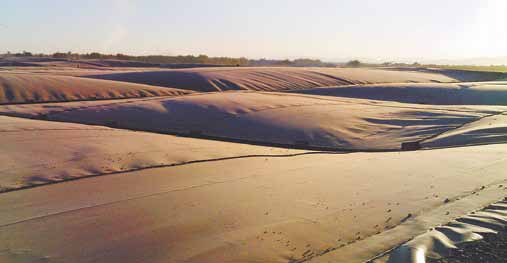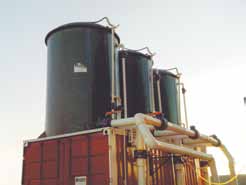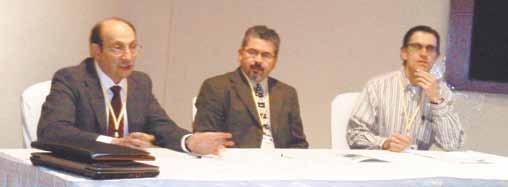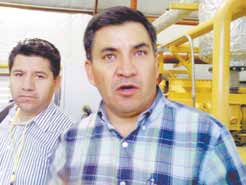
The largest biodigestion plant in Latin America, designed by Mexicans.
(Photos: Elizabeth Frausto Sotelo)
By converting manure into electricity, the livestock company Agrícola Ganadera Los Luján (AGL) is in the process of becoming certified to trade in the international carbon credit market.
The company owns the stables El Principal and El General, as well as Lujan Farm, which together have 14,500 cows, 8,000 of which are currently producing milk.
With the idea of entering the market in order to lessen the effects of climate change, a number of the company’s staff devised some of the components of the largest biomass processing plant in Latin America, in which methane gas from manure is used to generate electric current for its production line.
“The main goal is to help reduce air contamination and help control global warming through participation in the carbon bond market,” the company says.
According to accountant José Carrillo, head of the enormous dairy in the town of Delicias, the biomass processor can generate 649 kilowatts per hour and it avoids adding to the generation of the greenhouse gas methane by capturing and using it to power the milk production process.
AGL sells about 66,000 gallons of milk daily, of which 53,000 gallons go to the milk processor Alpura. They sell about 1,300 steers annually, and also fodder cultivated on 2,224 acres. Additionally, AGL runs a cutting-edge food processing plant in which it has invested about US$2.9 million.
The biomass processing project has been in operation for 3 years. So far, US$3.3 million has been invested, with an expected return within about 5 years.
The three stables have a water power-washing system to clean the stalls and each day they use over 528,300 gallons of water. All of the water and cow urine goes into the biomass processor tank.
The processor is approximately 700 feet long, 371 feet wide, and 26 feet deep. It has a capacity of 36.4 million gallons of wáter. For it to function, 99 percent of the solids in the water have to be extracted. Manure is the most abundant solid and it is removed by a special solid separating device.
The comercial separator is only sold in the United States. According to Carrillo, the company saw the need to build its own for cost reasons, since it does not receive help from the government or other private companies, he says.
The water is held in the tank for 69 days. During this period, the bacteria in the liquid generate gases. For the bacteria to do their work,

“The population is growing and consequently so is the demand for water and energy.” said Christopher Scott of the University of Arizona.
This is of particular concern in Arizona, where a study was done to determine how much water is being used and how much energy is required, he explained. Likewise, they have realized the importance of protecting the groundwater aquifers for future generations. For that reason, they began a desalinization project which has produced good results so far, he says.
On the other hand, Sergio Alfonso Cano Fonseca of Conagua (the National Water Commission) in Chihuahua stated that the reuse of water for irrigation in the Municipality of Delicias is a good utilization of this precious liquid.
He mentioned that this technique is about to be adopted in the city of Juarez where it is also expected to be a success.
Among the speakers were Maher Kelada of MIK Technology and Humberto Silva Hidalgo from Chihuahua’s Central Water and Sewage Board, who both believe that desalinization is the best option for providing the population with water.
 The biodigestion project has been in operation for three years with an investment so far of US$3.3 million.
The biodigestion project has been in operation for three years with an investment so far of US$3.3 million.
 Presenters Maher Kelada (MIK Technology), Humberto Silva Hidalgo (Central Water and Sewage Board of Chihuahua), and Christopher Scott (University of Arizona). (Photo: Elizabeth Frausto Sotelo)
Presenters Maher Kelada (MIK Technology), Humberto Silva Hidalgo (Central Water and Sewage Board of Chihuahua), and Christopher Scott (University of Arizona). (Photo: Elizabeth Frausto Sotelo)
 José Carrillo is in charge of the biodigestion plant in the municipality of Delicias.
José Carrillo is in charge of the biodigestion plant in the municipality of Delicias. boat propellers keep the water in constant motion. The methane accumulates at the surface and does not escape because the processor is enclosed by a rubber cover.
The methane is used to fuel the motor that generates electricity. This energy is then used to power the factory farm, resulting in lower production costs.
In addition to being in the process of being certified by by the United Nations Organization (UNO), in 2007, AGL won First Place, Basic Level in Alpura’s Raw Milk Quality group and the 2008 National Agri-Food Award.
AGL was started in 1968 with a herd of 40 cows brought from Canada. The company is able to take advantage of Chihuahua’s dry weather and major aquifers that favor the cultivation of fodder and breeding of large numbers of livestock.
Carrillo said the company employs about 283 people, who are supported with both scholarships and flexible schedules so they can pursue continuing education. What he likes best personally is when children from nearby schools come to visit. They show great interest and enthusiasm, he says.